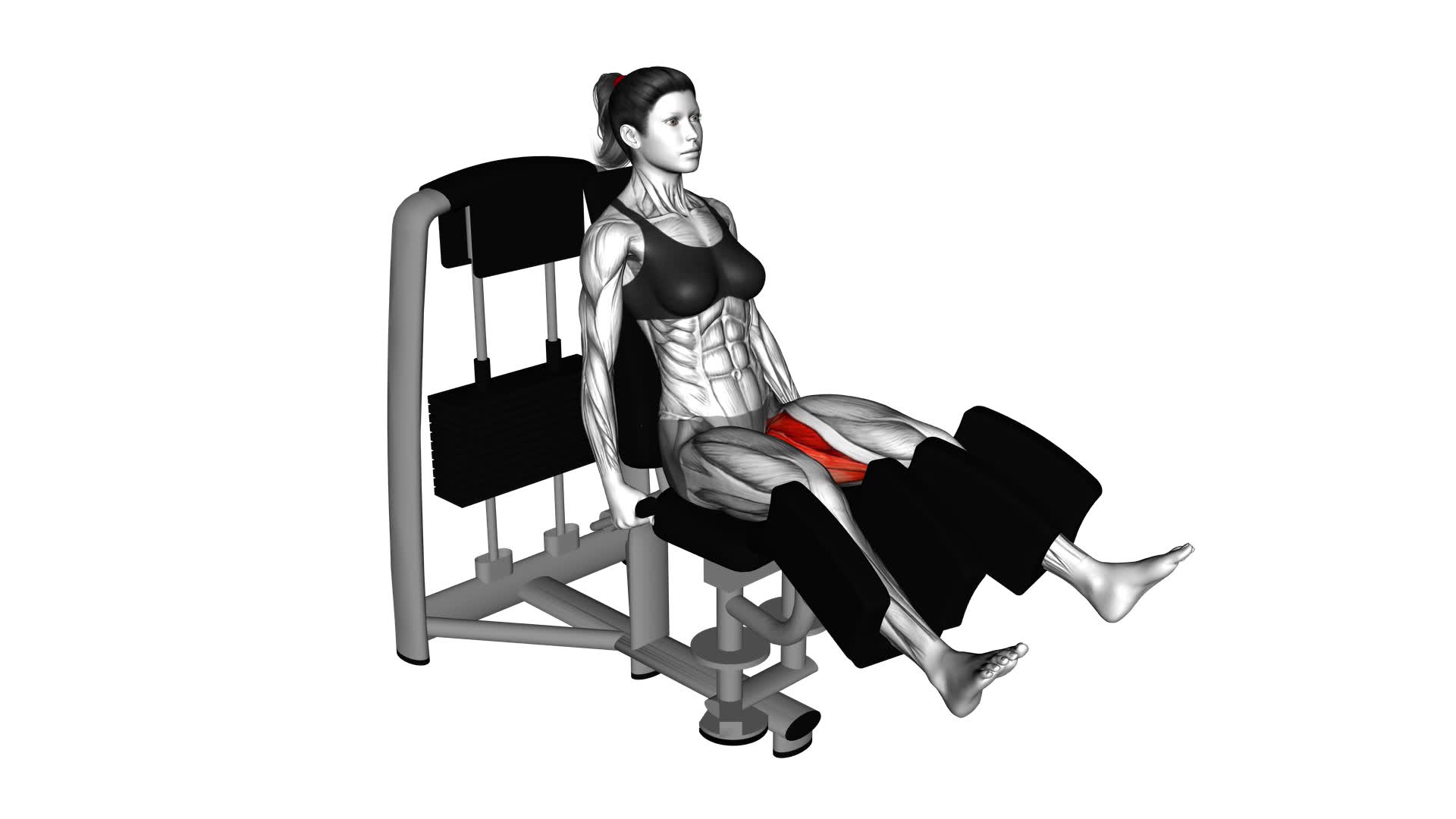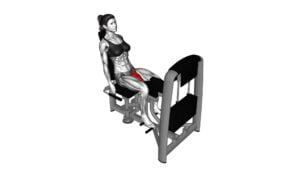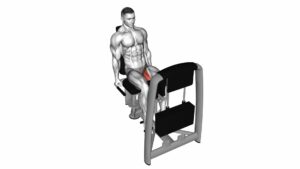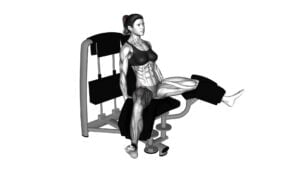Lever Seated Hip Adduction (VERSION 2) (female) – Video Exercise Guide & Tips

Are you looking to strengthen your hip muscles and improve your overall lower body strength? Look no further than lever seated hip adduction.
Watch This Exercise Video
In this version, specifically designed for females, you'll learn the proper form and technique to maximize the benefits of this exercise. Avoid common mistakes, make modifications, and progress at your own pace.
Get ready for a safe and effective workout that will leave your hips feeling stronger than ever before. Let's get started!
Key Takeaways
- Lever seated hip adduction targets and strengthens the inner thigh muscles.
- It helps in improving hip stability and overall stability of the hips.
- Lever seated hip adduction is beneficial for various activities such as running, jumping, and walking.
- Proper form and technique, such as maintaining a neutral spine and engaging core muscles, are important for effective and safe execution of the exercise.
Benefits of Lever Seated Hip Adduction
One benefit of lever seated hip adduction is that it targets and strengthens the inner thigh muscles. This exercise specifically activates the adductor muscles, which are responsible for moving the thigh towards the midline of the body. By performing lever seated hip adduction, you can effectively isolate and work these muscles, helping to tone and strengthen them.
In addition to targeting the inner thigh muscles, lever seated hip adduction also helps in improving hip stability. The adductor muscles play a crucial role in stabilizing the hip joint, especially during movements that require balance and coordination. By strengthening these muscles, you can enhance the overall stability of your hips, which can be beneficial in various activities such as running, jumping, and even everyday movements like walking and climbing stairs.
Proper Form and Technique
To perform lever seated hip adduction with proper form and technique, you should position yourself on the machine and adjust the lever pads to fit snugly against your inner thighs. This will ensure proper alignment and provide a stable base for the exercise. Sit up straight and engage your core muscles to maintain a neutral spine throughout the movement.
To start, place your feet flat on the footrests and grasp the handles for stability. Keep your knees and ankles in line with each other and maintain a slight bend in your knees. This position will help activate the muscles in your hips and thighs effectively.
As you begin the movement, exhale and squeeze your inner thighs together, bringing the lever pads towards each other. Keep your movements controlled and avoid using momentum or excessive force. Inhale as you slowly return to the starting position.
Maintaining proper alignment is crucial during lever seated hip adduction. Focus on keeping your hips and pelvis stable and avoid any excessive twisting or leaning. Remember to engage your hip adductor muscles throughout the exercise to maximize muscle activation.
Common Mistakes to Avoid
To avoid common mistakes during lever seated hip adduction, make sure you keep your movements controlled and avoid using excessive force or momentum. By following these guidelines, you can prevent injuries and maximize the effectiveness of this exercise.
Here are some common mistakes to avoid:
- Jerky movements: Avoid making sudden, jerky movements during lever seated hip adduction. This can strain your muscles and increase the risk of injury. Instead, focus on maintaining smooth and controlled motions throughout the exercise.
- Using excessive force: Applying excessive force while performing the lever seated hip adduction can put unnecessary stress on your hip joints and muscles. It's important to use a weight that challenges you, but allows you to maintain proper form and control throughout the movement.
- Lack of range of motion: Failing to achieve the full range of motion can limit the effectiveness of the exercise. Make sure to fully squeeze your inner thighs together at the end of each repetition and return to the starting position without cutting the range short.
- Neglecting proper form: Keeping proper form is vital for injury prevention and optimal results. Avoid leaning forward or backward, and maintain a neutral spine throughout the exercise. Additionally, ensure that your knees are aligned with the machine and your feet are flat on the footrests.
Modifications and Progressions
To modify and progress the lever seated hip adduction exercise, you can adjust the weight or resistance and increase the number of repetitions or sets. Modifying the exercise allows you to tailor it to your specific needs and abilities, while progressing it challenges your muscles further.
One way to modify the lever seated hip adduction exercise is by adjusting the weight or resistance. If you're just starting out or have limited strength, you can decrease the weight or resistance to make the exercise more manageable. On the other hand, if you find the exercise too easy, you can increase the weight or resistance to provide a greater challenge for your muscles.
Another way to modify the exercise is by increasing the number of repetitions or sets. This can help to increase the overall volume of the exercise and provide additional stimulus for muscle growth and strength development. Start by adding a few extra repetitions or sets to your workout, and gradually increase them over time as you become more comfortable and proficient with the exercise.
For those looking for advanced variations of the lever seated hip adduction exercise, you can try performing the exercise with one leg at a time. This unilateral variation increases the challenge on the muscles of the inner thigh and can help to improve balance and stability. Additionally, you can also experiment with different tempos, such as performing the exercise at a slower pace to increase time under tension and enhance muscle activation.
Remember to always listen to your body and progress at a pace that's appropriate for your fitness level. By making modifications and exploring advanced variations, you can continue to challenge and improve your strength and muscular development.
Tips for a Safe and Effective Workout
To ensure a safe and effective workout, it's important to prioritize proper form and technique while performing the lever seated hip adduction exercise. Here are some tips to help you prevent injuries and track your progress:
- Maintain a neutral spine throughout the exercise. Keep your back straight and avoid rounding or arching it.
- Engage your core muscles by drawing your navel towards your spine. This will provide stability and support to your lower back.
- Start with a weight that challenges you, but allows you to maintain control and proper form. Gradually increase the weight as you get stronger and more comfortable with the movement.
- Avoid using momentum to perform the exercise. Instead, focus on using the muscles of your inner thighs to move the lever in a controlled manner.
To prevent injuries, it's crucial to listen to your body and never push through pain. If you experience any discomfort or pain during the exercise, stop immediately and consult with a qualified fitness professional. Additionally, always warm up before starting your workout and stretch afterwards to prevent muscle tightness and promote flexibility.
Tracking your progress can be a great motivator and help you stay on track with your fitness goals. Consider keeping a workout journal to record the weight, sets, and reps you perform during each session. This will allow you to track your progress over time and make adjustments to your training program as needed.
Frequently Asked Questions
What Are Some Alternative Exercises to Lever Seated Hip Adduction?
Looking for alternatives to lever seated hip adduction?
There are a few exercises that can target your hip adductor muscles and offer similar benefits. Try exercises like standing cable hip adduction, side plank hip adduction, or seated leg press with hip adduction.
These exercises can help strengthen the inner thighs and improve hip stability. Athletes can benefit from lever seated hip adduction as it can enhance their lower body strength and improve performance in sports that require lateral movements.
How Many Sets and Reps Should I Do for Lever Seated Hip Adduction?
For lever seated hip adduction, it's recommended to start with a weight and resistance that challenges you but still allows for proper form. Aim for 2-3 sets of 8-12 reps, with a rest period of 60-90 seconds between sets.
It's important to avoid common mistakes like using momentum instead of controlled movements, and not fully engaging the hip adductor muscles. Remember to maintain proper posture throughout the exercise for optimal results.
Can I Perform Lever Seated Hip Adduction if I Have a Hip Injury?
If you have a hip injury, it's best to consult with a healthcare professional before performing the lever seated hip adduction exercise. While this exercise can provide benefits such as strengthening the hip adductors, it may not be suitable for everyone with a hip injury.
Depending on the severity of your injury, modifications or alternative exercises may be recommended to avoid further discomfort or damage. Prioritize your safety and consult a professional for personalized advice.
Is Lever Seated Hip Adduction Suitable for Beginners?
Lever seated hip adduction is a suitable exercise for beginners to strengthen their hip muscles. It helps improve hip stability and mobility. However, modifications might be necessary for beginners who may not have the strength or range of motion to perform it correctly.
Some benefits of lever seated hip adduction include targeting the hip adductor muscles and enhancing overall lower body strength. Remember to consult with a fitness professional to ensure proper form and technique.
Can Lever Seated Hip Adduction Help With Weight Loss or Toning the Inner Thighs?
Lever seated hip adduction is an effective exercise for toning the inner thighs. It targets the adductor muscles, helping to strengthen and define them. When compared to standing hip adduction, lever seated hip adduction provides better isolation and resistance, making it more effective for targeting the inner thighs.
To incorporate lever seated hip adduction into a full body workout routine for maximum results, you can perform it after compound exercises like squats or lunges. This will ensure that your entire lower body gets worked out efficiently.
Conclusion
In conclusion, the lever seated hip adduction exercise is a beneficial workout for strengthening and toning the hip adductor muscles. By maintaining proper form and technique, you can effectively target these muscles and avoid common mistakes.
Modifications and progressions can be made to personalize the exercise to your fitness level. Remember to follow the tips provided for a safe and effective workout.
Incorporating this exercise into your routine can help improve hip stability and overall lower body strength.

Author
Years ago, the spark of my life’s passion ignited in my mind the moment I stepped into the local gym for the first time. The inaugural bead of perspiration, the initial endeavor, the very first surge of endorphins, and a sense of pride that washed over me post-workout marked the beginning of my deep-seated interest in strength sports, fitness, and sports nutrition. This very curiosity blossomed rapidly into a profound fascination, propelling me to earn a Master’s degree in Physical Education from the Academy of Physical Education in Krakow, followed by a Sports Manager diploma from the Jagiellonian University. My journey of growth led me to gain more specialized qualifications, such as being a certified personal trainer with a focus on sports dietetics, a lifeguard, and an instructor for wellness and corrective gymnastics. Theoretical knowledge paired seamlessly with practical experience, reinforcing my belief that the transformation of individuals under my guidance was also a reflection of my personal growth. This belief holds true even today. Each day, I strive to push the boundaries and explore new realms. These realms gently elevate me to greater heights. The unique combination of passion for my field and the continuous quest for growth fuels my drive to break new ground.







